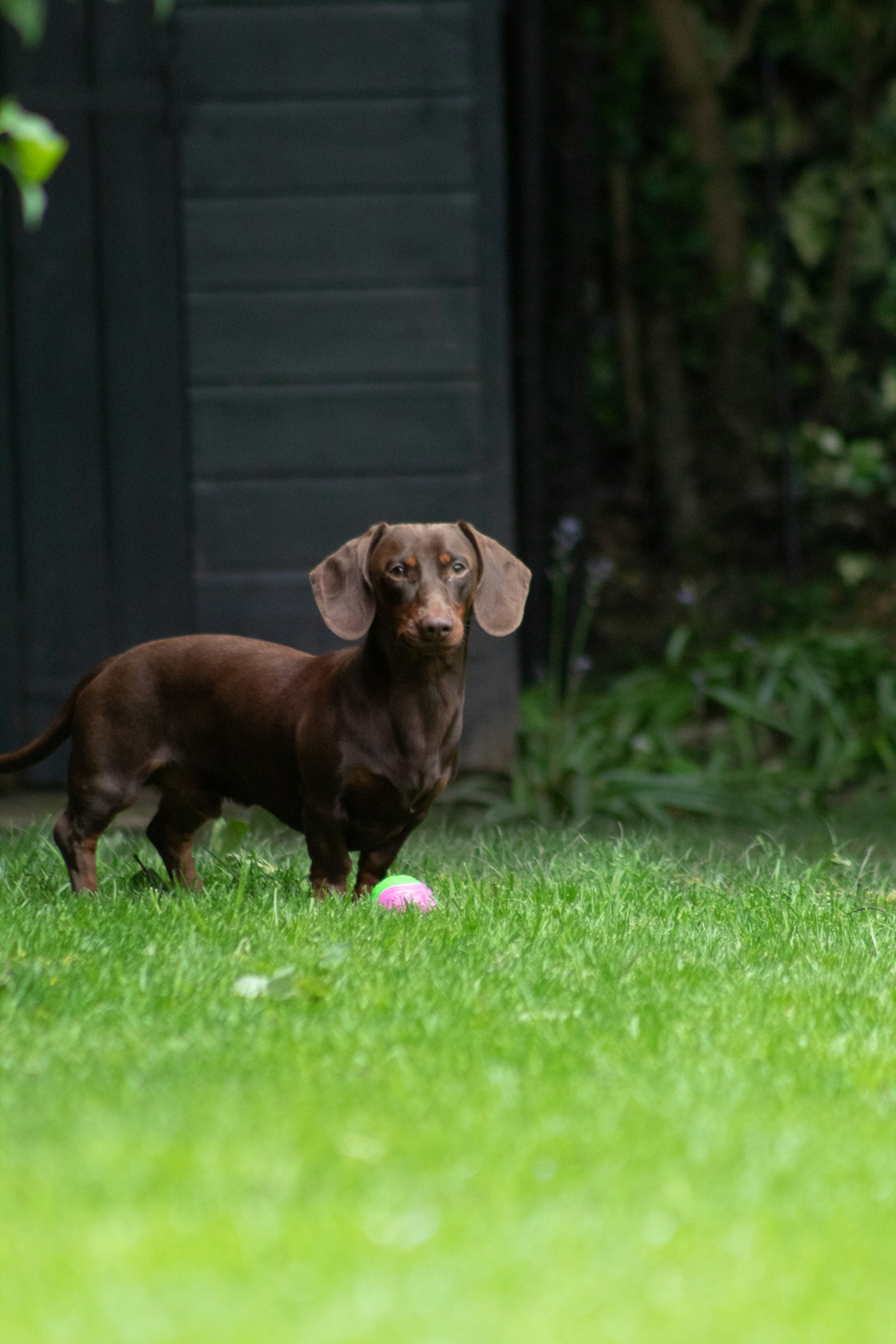Dachshunds, with their distinctive long bodies and short legs, capture the hearts of many dog enthusiasts. Yet, the question that often lingers is, "Are dachshunds easy to train?" Training any dog breed requires dedication and understanding, and dachshunds are no exception. In this article, we will explore the unique characteristics of dachshunds, the challenges owners may face, and effective training strategies to ensure a well-behaved and happy canine companion.

Dachshund Characteristics
Ah, the dachshund—the small dog with a big personality. If you've ever been enchanted by those short legs and long body, you know what I'm talking about. These little guys are a bundle of uniqueness. Physically, they stand out in a crowd with their unmistakable appearance. But it's not just about looks; it's about Dachshund temperament too.
Dachshunds aren't your average lapdog—they're more like a spirited adventurer in a tiny package. Their independent nature and bold demeanor make them a breed apart. So, when it comes to training, it's essential to understand these distinctive characteristics to bring out the best in your furry friend.
Perceived Challenges in Training Dachshunds
Now, let's address the elephant in the room—or should I say, the dachshund in the living room. Many folks wonder if dachshunds are a tough nut to crack when it comes to training. I get it; they've got a reputation for being a bit stubborn. But is it really as challenging as it seems?
Yes, they can be a tad headstrong, and that's where the challenge lies. Add to that their history as hunters, and you might find yourself wondering if you're training a happy dog or negotiating a peace treaty with a mini explorer. But fear not, understanding is the key.
Understanding Dachshund Psychology
Imagine you're dealing with a friend who speaks a different language. You wouldn't get frustrated; you'd try to understand, right? Dachshunds aren't much different. To train them effectively, you've got to get into their heads. Build a connection.
Recognizing their triggers and motivations is like finding the secret code to their hearts. Positive reinforcement is your secret weapon. Treats and rewards become your currency, and suddenly, you're speaking fluent dachshund. It's a two-way street of understanding and bonding.
So, yes, dachshunds may have their quirks, but once you've unlocked the mystery of their psychology, training becomes a shared adventure. Get ready for a journey of treats, tail wags, and the occasional head tilt that says, "I get you, human."
Positive Reinforcement Techniques
Now that we've dipped our toes into the enigmatic world of dachshund psychology, let's talk tactics—positive reinforcement style. Imagine training your dachshund as a grand treasure hunt. The prize? Not gold, but tasty treats and the joy of a job well done.
Dachshunds are smart cookies, and they respond remarkably well to positive reinforcement. Treats, pats, and an exuberant "good dog" transform your training sessions into canine celebrations. Think of it as bribery, but the kind that fosters good behavior. It's like saying, "Hey, nail this command, and there's a treat party waiting for you!"
And let's not forget the clicker. It's not just a noise; it's a symphony of success. Click, treat, repeat. It's the rhythm that transforms your dachshund into a maestro of obedience. Positive reinforcement isn't just a technique; it's the language of encouragement that speaks directly to your pup's heart.
Consistency in Training
Picture this: You're learning a new dance routine, and every time the music changes, so does the choreography. Confusing, right? Well, your dachshund feels the same way about inconsistent training. Consistency is the golden thread that weaves your commands into their everyday routine.
Establish clear boundaries and stick to them like glue. If today's "sit" means a treat, tomorrow's "sit" should too. Routine becomes your training ally. Dogs love predictability—it's like their security blanket. So, whether it's morning walks, mealtime, or bedtime, keep it consistent.
Think of it as being the director of a blockbuster movie, with your dachshund as the star. The script may have twists, but the main scenes—the commands—remain unchanged. Be the Spielberg of dachshund training, and watch your furry friend shine in the leading role.

Socialization for Dachshunds
Now, let's turn our attention to a crucial chapter in the dachshund training manual—socialization. Imagine your dachshund as a socialite, mingling at the canine cocktail party. But how do you turn your pup into the life of the doggy bash?
Expose them to different environments, people, and furry pals. It's like giving them a backstage pass to the world. From parks to pet-friendly cafes, let them dip their paws into the social scene. Meeting other dogs teaches them the art of doggy diplomacy, while encounters with humans build their confidence.
Think of socialization as the ultimate charm school for your dachshund. It prevents them from becoming the wallflowers of the dog park. So, let the mingling commence! A well-socialized dachshund isn't just a joy to be around; it's a testament to your training prowess. Cheers to playdates, tail wags, and a dachshund who struts through life like a social butterfly!
Training Methods for Specific Commands
Alright, buckle up! We're diving into the nitty-gritty of dachshund training—specific commands. Think of it as the ABCs of canine communication, where "sit" is like learning the alphabet. Ready to turn your dachshund into a command virtuoso? Let's roll.
Teaching basic commands is the cornerstone of a well-trained dachshund. Picture this: You say "sit," and your dachshund gracefully plants their little bum on the floor. The secret sauce? Consistency and patience.
"Stay" and "Come" are like the next chapters in your training novel. Think of it as teaching your pup to perform a mini-play. "Stay" is the dramatic pause, and "Come" is the grand entrance. With treats and positive reinforcement, you're not just a trainer; you're a canine Shakespeare.
Now, let's talk about the rebels—barking and digging. They're like the Shakespearean villains but fear not, there's a hero in our story: training. Addressing these behaviors requires a mix of redirection, positive reinforcement, and a dash of distraction. Consider it the script doctoring phase of your training masterpiece.
Training Challenges and Solutions
Training a dachshund isn't always a walk in the park—more like a brisk trot with occasional detours. Challenges pop up like unexpected plot twists, but fear not, every challenge is just a stepping stone to success.
Stubbornness might be your nemesis, but remember, patience is your superpower. If your dachshund gives you the classic "I'll sit when I feel like it" look, take a deep breath, offer a treat, and try again. Consistency is your ally in this epic battle of wills.
Now, the real head-scratcher—potty training. Picture it as teaching your dachshund the fine art of bathroom etiquette. Set a routine, reward their outdoor accomplishments, and be prepared for the occasional mishap. Accidents happen; it's part of the training plotline.
And what about the ultimate showdown—chewing? Your shoes might feel like sacrificial lambs, but with chew toys and a gentle "no," you'll save your footwear from an untimely demise. Chew toys become the heroes in this tale of teething.
Advanced Training for Dachshunds
So, you've conquered the basics; now it's time to level up. Welcome to the world of advanced dog training, where your dachshund becomes the James Bond of the canine world—sophisticated, skilled, and utterly charming.
Agility training is like a canine obstacle course, turning your dachshund into a four-legged ninja. Jumps, tunnels, and weave poles become their mission, should they choose to accept it. It's not just exercise; it's a mental workout that keeps your dachshund sharp and agile.
Mastering advanced obedience commands is the final act. Picture your dachshund responding to commands like a seasoned actor hitting their cues. From "shake" to "roll over," it's a symphony of skills that showcases the brilliance of your well-trained companion.
Advanced training isn't just about showcasing your dachshund's talents; it's about fostering a deeper connection. So, grab your clicker, a pocketful of treats, and get ready for the applause. Your dachshund's advanced training journey is the blockbuster sequel to your training saga.
Training Tips for Dachshund Puppies
Ah, the puppy days—a whirlwind of fluffy cuteness, boundless energy, and the occasional chewed-up slipper. If you've just welcomed a dachshund pup into your home, it's time to lay the foundation for a lifetime of good behavior. Let the training games begin!
Start early, my friend. Dachshund puppies are like sponges, soaking up knowledge with every wiggle of their tails. Begin with basic commands like "sit" and "stay." Keep it short, sweet, and filled with positive reinforcement—treats are like magic spells in puppy training land.
Gentle socialization is the secret sauce. Introduce your pup to different sights, sounds, and people. It's like creating a diverse playlist for their little ears. The goal? A well-adjusted, confident dachshund who can navigate the world like a champ.
And remember, patience is your puppy-training virtue. Rome wasn't built in a day, and your dachshund won't become a canine Einstein overnight. Enjoy the puppy antics, celebrate the victories, and know that you're shaping a future superstar.
Dachshund Training Success Stories
Let's switch gears to the tales of triumph—dachshund training success stories. Picture this: A once-headstrong dachshund transformed into an obedience maestro. These stories are the golden pot of motivation at the end of the training rainbow.
Take Max, for instance. Stubborn as a mule, they said. But with consistent positive reinforcement and a dash of creativity, Max mastered every command in the book. From "roll over" to "fetch," Max's success is a testament to the power of patience and perseverance.
Then there's Daisy, the queen of digging. A garden disaster waiting to happen. Yet, with redirection, a designated digging area, and a sprinkle of praise, Daisy turned from a backyard archaeologist into a well-behaved outdoor companion.
These success stories aren't just heartwarming tales; they're blueprints for your own training journey. Learn from the triumphs of others, adapt strategies to fit your dachshund's personality, and let those success stories be the wind beneath your training wings.
Common Mistakes in Dachshund Training
Now, let's address the proverbial elephant in the room—common mistakes in dachshund training. Picture this scenario: You're teaching "stay," and your dachshund interprets it as an invitation for a joyous sprint around the room. Sound familiar? We've all been there.
One common misstep is inconsistency. Imagine a world where traffic lights change rules daily—it would be chaos. The same goes for training. Be the unwavering traffic light, signaling clear and consistent commands.
Using harsh training methods is another pitfall. Your dachshund is no gladiator; they're your adorable companion. Positive reinforcement is the hero of this story. Scolding and punishment create confusion and separation anxiety, not a well-trained pup.
And let's not forget the sin of overlooking basic commands. A dachshund who thinks "sit" means "maybe sit if you feel like it" is a recipe for chaos. Nail the basics before embarking on advanced training adventures.
In the grand saga of dachshund training, mistakes happen. The key is to acknowledge, learn, and adjust the course. Your dachshund is forgiving, and every training mishap is a stepping stone to a more resilient and well-trained companion.
Conclusion
In conclusion, while dachshunds may present unique challenges in training, a patient and positive approach, coupled with understanding their distinctive characteristics, can lead to a well-trained and happy companion. The key lies in building a strong bond, incorporating consistent positive reinforcement techniques, and addressing challenges with resilience.

Frequently Asked Questions (FAQs)
- What age is best to start training a dachshund?
- Training can start as early as 8 weeks, focusing on basic commands and gentle socialization.
- How long does it take to train a dachshund?
- The duration varies, but with consistency, basic commands can be learned within a few weeks.
- Can dachshunds be trained to get along with other pets?
- Yes, early socialization and positive reinforcement can help dachshunds get along with other pets.
- Are professional dog trainers necessary for dachshunds?
- While not mandatory, professional trainers can provide valuable guidance, especially for first-time owners.
- How to handle stubborn behavior during training?
- Patience, positive reinforcement, and understanding the root cause of stubbornness are key in addressing this behavior.